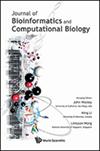Quantitative structure-activity relationship modeling reveals the minimal sequence requirement and amino acid preference of sirtuin-1's deacetylation substrates in diabetes mellitus
IF 0.7
4区 生物学
Q4 MATHEMATICAL & COMPUTATIONAL BIOLOGY
Journal of Bioinformatics and Computational Biology
Pub Date : 2022-04-21
DOI:10.1142/S0219720022500081
引用次数: 0
Abstract
Sirtuin 1 (SIRT1) is a nicotinamide adenine dinucleotide (NAD[Formula: see text]-dependent deacetylase involved in multiple glucose metabolism pathways and plays an important role in the pathogenesis of diabetes mellitus (DM). The enzyme specifically recognizes its deacetylation substrates' peptide segments containing a central acetyl-lysine residue as well as a number of amino acids flanking the central residue. In this study, we attempted to ascertain the minimal sequence requirement (MSR) around the central acetyl-lysine residue of SIRT1 substrate-recognition sites as well as the amino acid preference (AAP) at different residues of the MSR window through quantitative structure-activity relationship (QSAR) strategy, which would benefit our understanding of SIRT1 substrate specificity at the molecular level and is also helpful to rationally design substrate-mimicking peptidic agents against DM by competitively targeting SIRT1 active site. In this procedure, a large-scale dataset containing 6801 13-mer acetyl-lysine peptides (and their SIRT1-catalyized deacetylation activities) were compiled to train 10 QSAR regression models developed by systematic combination of machine learning methods (PLS and SVM) and five amino acids descriptors (DPPS, T-scale, MolSurf, [Formula: see text]-score, and FASGAI). The two best QSAR models (PLS+FASGAI and SVM+DPPS) were then employed to statistically examine the contribution of residue positions to the deacetylation activity of acetyl-lysine peptide substrates, revealing that the MSR can be represented by 5-mer acetyl-lysine peptides that meet a consensus motif X[Formula: see text]X[Formula: see text]X[Formula: see text](AcK)0X[Formula: see text]. Structural analysis found that the X[Formula: see text] and (AcK)0 residues are tightly packed against the enzyme active site and confer both stability and specificity for the enzyme-substrate complex, whereas the X[Formula: see text], X[Formula: see text] and X[Formula: see text] residues are partially exposed to solvent but can also effectively stabilize the complex system. Subsequently, a systematic deacetylation activity change profile (SDACP) was created based on QSAR modeling, from which the AAP for each residue position of MSR was depicted. With the profile, we were able to rationally design an SDACP combinatorial library with promising deacetylation activity, from which nine MSR acetyl-lysine peptides as well as two known SIRT1 acetyl-lysine peptide substrates were tested by using SIRT1 deacetylation assay. It is revealed that the designed peptides exhibit a comparable or even higher activity than the controls, although the former is considerably shorter than the latter.定量构效关系模型揭示了糖尿病患者sirtuin-1脱乙酰基底物的最小序列需求和氨基酸偏好
Sirtuin 1(SIRT1)是一种烟酰胺腺嘌呤二核苷酸(NAD[公式:见正文]依赖性脱乙酰酶,参与多种葡萄糖代谢途径,在糖尿病(DM)的发病机制中发挥重要作用。该酶特异性识别其脱乙酰基底物的肽段,该肽段包含中心乙酰赖氨酸残基以及位于中心残基两侧的许多氨基酸。在本研究中,我们试图通过定量构效关系(QSAR)策略来确定SIRT1底物识别位点的中心乙酰赖氨酸残基周围的最小序列需求(MSR)以及MSR窗口不同残基处的氨基酸偏好(AAP),这将有利于我们在分子水平上理解SIRT1底物特异性,也有助于通过竞争性靶向SIRT1活性位点来合理设计针对DM的底物模拟肽剂。在该程序中,汇编了一个包含6801个13聚体乙酰赖氨酸肽(及其SIRT1催化脱乙酰活性)的大规模数据集,以训练10个QSAR回归模型,该模型是通过机器学习方法(PLS和SVM)和5个氨基酸描述符(DPPS、T量表、MolSurf、[公式:见正文]-score和FASGAI)的系统组合开发的。然后,使用两个最佳的QSAR模型(PLS+FASGAI和SVM+DPPS)来统计检查残基位置对乙酰赖氨酸肽底物的脱乙酰活性的贡献,揭示MSR可以由满足一致基序X的5-聚乙酰赖氨肽来表示[公式:见正文]X[公式:见正文]X(公式:见文本](AcK)0X[公式:见图]。结构分析发现,X[式:见正文]和(AcK)0残基紧密堆积在酶活性位点上,并赋予酶-底物复合物稳定性和特异性,而X[式,见正文]、X[式和X[式]残基部分暴露于溶剂中,但也能有效稳定复合物系统。随后,基于QSAR建模创建了系统的脱乙酰基活性变化谱(SDACP),从中描绘了MSR每个残基位置的AAP。利用该图谱,我们能够合理地设计出一个具有良好脱乙酰活性的SDACP组合文库,从中通过SIRT1脱乙酰测定测试了9个MSR乙酰赖氨酸肽和两个已知的SIRT1乙酰赖氨肽底物。研究表明,设计的肽表现出与对照相当甚至更高的活性,尽管前者比后者短得多。
本文章由计算机程序翻译,如有差异,请以英文原文为准。
求助全文
约1分钟内获得全文
求助全文
来源期刊

Journal of Bioinformatics and Computational Biology
MATHEMATICAL & COMPUTATIONAL BIOLOGY-
CiteScore
2.10
自引率
0.00%
发文量
57
期刊介绍:
The Journal of Bioinformatics and Computational Biology aims to publish high quality, original research articles, expository tutorial papers and review papers as well as short, critical comments on technical issues associated with the analysis of cellular information.
The research papers will be technical presentations of new assertions, discoveries and tools, intended for a narrower specialist community. The tutorials, reviews and critical commentary will be targeted at a broader readership of biologists who are interested in using computers but are not knowledgeable about scientific computing, and equally, computer scientists who have an interest in biology but are not familiar with current thrusts nor the language of biology. Such carefully chosen tutorials and articles should greatly accelerate the rate of entry of these new creative scientists into the field.
 求助内容:
求助内容: 应助结果提醒方式:
应助结果提醒方式:


